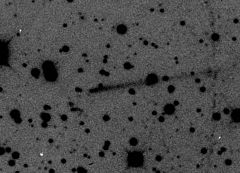P / 2010 A2 (LINEAR)
| P / 2010 A2 (LINEAR) [i] | |
|---|---|

|
|
| Image taken with a 24 " Ritchey-Chrétien reflector with an exposure time of eight minutes | |
| Properties of the orbit ( animation ) | |
| Orbit type | short-term |
| Numerical eccentricity | 0.12 |
| Perihelion | 2.01 AU |
| Aphelion | 2.58 AU |
| Major semi-axis | 2.29 AU |
| Sidereal period | 3.47 a |
| Inclination of the orbit plane | 5.26 ° |
| Orbital velocity in the perihelion | 54.6 km / s |
| Physical properties of the core | |
| Medium diameter | (220 ± 40) m |
| history | |
| Explorer | LINEAR ( 704 ) |
| Date of discovery | January 6, 2010 |
| Source: Unless otherwise stated, the data comes from JPL Small-Body Database Browser . Please also note the note on comet articles . | |
Comet P / 2010 A2 (LINEAR) is a small body in the solar system that also shows the typical characteristics of comets and asteroids . It was therefore given the name of a comet at the beginning.
The object runs in the main belt of the asteroids and also has a comet's tail. The position of the nucleus is noteworthy as it is out of the coma. Something like this has never been seen in comets before.
P / 2010 A2 was discovered on January 6, 2010 by Lincoln Near Earth Asteroid Research (LINEAR) with a one meter reflecting telescope on a CCD image. It was observed on 112 days of its 3.5 year orbit around the sun. He reached perihelion in early December 2009.
With an aphelion of 2.6 AU, P / 2010 A2 remains within the ice line of the solar system of 2.7 AU for the entire orbit period . Beyond the ice line, volatile ice particles are more common. Although no water or other gases were detected, it could not be ruled out that the comet's tail was caused by gases. Model calculations indicate that the asteroid began its activity at the end of March 2009, peaked in June 2009 and ceased activity in December 2009.
An analysis of images from the Hubble telescope shows a tail of dust and gravel that was created by a collision with another asteroid. At the Max Planck Institute , the perspective of the Rosetta probe was used to date the collision of the asteroids. After extensive simulations, the researchers are of the opinion that the collision took place on February 10, 2009, to within 10 days.
P / 2010 A2 is likely 150 meters in diameter. When it was discovered, it was assumed that it would be less than 500 meters in diameter.
The orbit of P / 2010 A2 matches the asteroid group of the Flora family that formed 100 million years ago.
Centaur (60558) Echeclus is a similar object.
 The tail of P / 2010 A2 is made up of the debris from a collision between two small asteroids.  Suspected cometary nucleus on the lower left side of the debris field |
See also
Individual evidence
- ^ A b Javier Méndez: Comet P / 2010 A2, an Activated Asteroid from the Main Asteroid Belt . Isaac Newton Group of Telescopes (ING). July 23, 2010. Retrieved July 27, 2010.
- ↑ a b c d Harrington, JD, Villard, R .: Suspected Asteroid Collision Leaves Trailing Debris . NASA Release: 10-029. February 2, 2010. Retrieved February 3, 2010.
- ↑ a b c d e JPL Small-Body Database Browser: P / 2010 A2 (LINEAR) . February 1, 2010. Retrieved February 3, 2010.
- ^ A b c Brian G. Marsden: MPEC 2010-A32: COMET P / 2010 A2 (LINEAR) . In: IAU Minor Planet Center . Harvard-Smithsonian Center for Astrophysics. January 7, 2010. Retrieved January 14, 2010.
- ^ A b David C. Jewitt : P / 2010 A2 (LINEAR): The 5th Main-Belt Comet . UCLA (Department of Earth and Space Sciences). Retrieved January 20, 2010.
- ^ HST Sees Evidence of Colliding Asteroids, Astronomy Today , Feb. 2, 2010
- ↑ David C. Jewitt : P / 2010 A2 (LINEAR): Possible Asteroid Smash . UCLA (Department of Earth and Space Sciences). Retrieved February 3, 2010.
- ^ Glossary of Astronomical Terms (Ice line) . Glossary of Astronomical Terms. Archived from the original on February 14, 2010. Retrieved January 20, 2010.
- ↑ Max Planck Institute for Solar System Research Securing evidence after an asteroid crash (press release 13/2010 - October 13, 2010) Retrieved on June 22, 2014
- ↑ Jonathan Shanklin: BAA Comet Section: Comets discovered in 2010 . Institute of Astronomy (British Astronomical Association). January 18, 2010. Retrieved January 21, 2010.
- ↑ Jeff Hecht: Hybrid comet-asteroid in mysterious break-up . NewScientist.com news service. April 11, 2006. Retrieved April 18, 2006.
Web links
- Orbital simulation from JPL (Java) / Horizons Ephemeris
- Image of Comet P / 2010 A2 (Muler 12 " Meade LX200 )
- The Curious Case of Comet LINEAR (1.8-m telescope on Kitt Peak)
- Suspected Asteroid Collision Leaves Odd X-Pattern of Trailing Debris ( Hubble Space Telescope WFC3 2010 January 29 image)
- Karl Urban collision cloud instead of comet tail (February 4, 2010, 4:09 pm) Retrieved October 18, 2010
